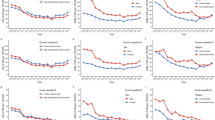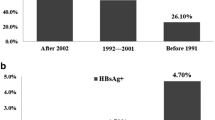Abstract
Background
In Taiwan, the national hepatitis B virus vaccination program and national viral hepatitis therapy program were implemented to control the infections of hepatitis viruses and their progressive illnesses. Studies have evaluated the impacts of two national health programs on many liver-related diseases, but not on acute and chronic viral hepatitis. The purpose of this study was to evaluate the impact on the mortality of acute and chronic viral hepatitis.
Methods
Poisson regression models were used to estimate the adjusted rate ratios of the different period groups and corresponding 95% confidence intervals for childhood, adulthood and elderhood, and to estimate the adjusted rate ratios of vaccinated cohorts and corresponding 95% confidence intervals.
Results
Compared with period of 2000–2003, the adjusted rate ratios for period groups of 2008–2011 and 2012–2015 reported a significantly increasing risk of acute and chronic viral hepatitis mortality, except for the childhood and female adulthood. For population without vaccination, the adjusted rate ratios of acute and chronic viral hepatitis B mortality were 0.99 (95% CIs 0.88–1.12), 1.30 (95% CIs 1.17–1.45) and 1.42 (95% CIs 1.28–1.55) for periods of 2004–2007, 2008–2011 and 2012–2015, respectively, comparing with unimplemented period of national viral hepatitis therapy program. Compared with 1967–1983 cohorts, the adjusted rate ratio of 1984–2000 cohorts was 0.46 (95% CIs 0.28–0.75), and the adjusted rate ratios were 0.49 (95% CIs 0.28–0.87) and 0.35 (95% CIs 0.11–1.05) for male and female, respectively.
Conclusion
This study revealed the significantly higher mortality rates of acute and chronic viral hepatitis during the implemented period of national viral hepatitis therapy program, comparing the unimplemented period. Such ineffectiveness may be attributable to the low coverage rate. The national vaccination program was currently an effective strategy for controlling the mortality of viral hepatitis.



Similar content being viewed by others
Abbreviations
- HBV:
-
Hepatitis B virus
- HCV:
-
Hepatitis C virus
- ICD:
-
International classification of disease
- CIs:
-
Confidence intervals
- DAAs:
-
Direct-acting antiviral agents
- AAs:
-
Aristolochic acids and their derivatives
- WHO:
-
World Health Organization
References
Polaris Observatory C. Global prevalence, treatment, and prevention of hepatitis B virus infection in 2016: a modelling study. Lancet Gastroenterol Hepatol 2018;3(6):383–403. https://doi.org/10.1016/S2468-1253(18)30056-6
Polaris Observatory HCVC. Global prevalence and genotype distribution of hepatitis C virus infection in 2015: a modelling study. Lancet Gastroenterol Hepatol 2017;2(3):161–176. https://doi.org/10.1016/S2468-1253(16)30181-9
Stanaway JD, Flaxman AD, Naghavi M, Fitzmaurice C, Vos T, Abubakar I, et al. The global burden of viral hepatitis from 1990 to 2013: findings from the Global Burden of Disease Study 2013. Lancet 2016;388(10049):1081–1088. https://doi.org/10.1016/S0140-6736(16)30579-7
Chen DS. Hepatocellular carcinoma in Taiwan. Hepatol Res 2007;37(Suppl 2):S101–S105. https://doi.org/10.1111/j.1872-034X.2007.00170.x
Centers for Disease Control, Department of Health, Taiwan, ROC. Annual report 2012. http://www.cdc.gov.tw/uploads/files/201208/67addf76-04934d7b-aa72-cd51beff6654.pdf. Accessed 17 Feb 2013
Chen DS, Hsu NH, Sung JL, Hsu TC, Hsu ST, Kuo YT, et al. A mass vaccination program in Taiwan against hepatitis B virus infection in infants of hepatitis B surface antigen-carrier mothers. JAMA 1987;257(19):2597–2603
Ministry of Health and Welfare, Taiwan, ROC. Taiwan Public Health Report 2012. http://www.mohw.gov.tw/EN/Ministry/DM2_P.aspx?f_list_no5475&fod_list_no5853&doc_no529943. Accessed 16 Aug 2013
Chien YC, Jan CF, Kuo HS, Chen CJ. Nationwide hepatitis B vaccination program in Taiwan: effectiveness in the 20 years after it was launched. Epidemiol Rev 2006;28:126–135. https://doi.org/10.1093/epirev/mxj010
Chiang CJ, Yang YW, You SL, Lai MS, Chen CJ. Thirty-year outcomes of the national hepatitis B immunization program in Taiwan. JAMA 2013;310(9):974–976. https://doi.org/10.1001/jama.2013.276701
Chang CH, Lin JW, Wu LC, Liu CH, Lai MS. National antiviral treatment program and the incidence of hepatocellular carcinoma and associated mortality in Taiwan: a preliminary report. Med Care 2013;51(10):908–913. https://doi.org/10.1097/MLR.0b013e3182a502ba
Chiang CJ, Yang YW, Chen JD, You SL, Yang HI, Lee MH, et al. Significant reduction in end-stage liver diseases burden through the national viral hepatitis therapy program in Taiwan. Hepatology 2015;61(4):1154–1162. https://doi.org/10.1002/hep.27630
Ni YH, Chang MH, Jan CF, Hsu HY, Chen HL, Wu JF, et al. Continuing decrease in hepatitis B virus infection 30 years after initiation of infant vaccination program in Taiwan. Clin Gastroenterol Hepatol 2016;14(9):1324–1330. https://doi.org/10.1016/j.cgh.2016.04.030
Chang MH, You SL, Chen CJ, Liu CJ, Lai MW, Wu TC, et al. Long-term effects of hepatitis B immunization of infants in preventing liver cancer. Gastroenterology 2016;151(3):472–480 e1. https://doi.org/10.1053/j.gastro.2016.05.048
Tillmann HL, Zachou K, Dalekos GN. Management of severe acute to fulminant hepatitis B: to treat or not to treat or when to treat? Liver Int 2012;32(4):544–553. https://doi.org/10.1111/j.1478-3231.2011.02682.x
Wong VW, Wong GL, Yiu KK, Chim AM, Chu SH, Chan HY, et al. Entecavir treatment in patients with severe acute exacerbation of chronic hepatitis B. J Hepatol 2011;54(2):236–242. https://doi.org/10.1016/j.jhep.2010.06.043
Yu W, Zhao C, Shen C, Wang Y, Lu H, Fan J. The efficacy and safety of Nucleos(t)ide analogues in patients with spontaneous acute exacerbation of chronic hepatitis B: a systematic review and meta-analysis. PLoS One 2013;8(6):e65952. https://doi.org/10.1371/journal.pone.0065952
Spengler U. Direct antiviral agents (DAAs)—a new age in the treatment of hepatitis C virus infection. Pharmacol Ther 2018;183:118–126. https://doi.org/10.1016/j.pharmthera.2017.10.009
Chen CF, Lee WC, Yang HI, Chang HC, Jen CL, Iloeje UH, et al. Changes in serum levels of HBV DNA and alanine aminotransferase determine risk for hepatocellular carcinoma. Gastroenterology 2011;141(4):1240-1248, 8 e1-2. https://doi.org/10.1053/j.gastro.2011.06.036
Lee MH, Yang HI, Lu SN, Jen CL, Yeh SH, Liu CJ, et al. Hepatitis C virus seromarkers and subsequent risk of hepatocellular carcinoma: long-term predictors from a community-based cohort study. J Clin Oncol 2010;28(30):4587–4593. https://doi.org/10.1200/JCO.2010.29.1500
Global Burden of Disease Cancer C, Fitzmaurice C, Allen C, Barber RM, Barregard L, Bhutta ZA, et al. Global, regional, and national cancer incidence, mortality, years of life lost, years lived with disability, and disability-adjusted life-years for 32 cancer groups, 1990 to 2015: a systematic analysis for the global burden of disease study. JAMA Oncol 2017;3(4):524–548. https://doi.org/10.1001/jamaoncol.2016.5688
Poon SL, Pang ST, McPherson JR, Yu W, Huang KK, Guan P, et al. Genome-wide mutational signatures of aristolochic acid and its application as a screening tool. Sci Transl Med 2013;5(197):197ra01. https://doi.org/10.1126/scitranslmed.3006086
Ng AWT, Poon SL, Huang MN, Lim JQ, Boot A, Yu W, et al. Aristolochic acids and their derivatives are widely implicated in liver cancers in Taiwan and throughout Asia. Sci Transl Med 2017;9(412):eaan6446. https://doi.org/10.1126/scitranslmed.aan6446
Su WJ, Liu CC, Liu DP, Chen SF, Huang JJ, Chan TC, et al. Effect of age on the incidence of acute hepatitis B after 25 years of a universal newborn hepatitis B immunization program in Taiwan. J Infect Dis 2012;205(5):757–762. https://doi.org/10.1093/infdis/jir852
Wait S, Chen DS. Towards the eradication of hepatitis B in Taiwan. Kaohsiung J Med Sci 2012;28(1):1–9. https://doi.org/10.1016/j.kjms.2011.10.027
Su S-Y, Chiang C-J, Yang Y-W, Lee W-C. Secular trends in liver cancer incidence from 1997 to 2014 in Taiwan and projection to 2035: an age-period-cohort analysis. J Formosan Med Assoc 2019;118:444–449. https://doi.org/10.1016/j.jfma.2018.07.001
World Health Organization. Global health sector strategy on viral hepatitis 2016–2021. http://www.who.int/hepatitis/strategy2016-2021/ghss-hep/en/. Accessed June 2016
Lin YY, Huang CS. Aging in Taiwan: building a society for active aging and aging in place. Gerontologist 2016;56(2):176–183. https://doi.org/10.1093/geront/gnv107
Wang HH, Tsay SF. Elderly and long-term care trends and policy in Taiwan: challenges and opportunities for health care professionals. Kaohsiung J Med Sci 2012;28(9):465–469. https://doi.org/10.1016/j.kjms.2012.04.002
Executive Yuan, Taiwan, ROC. Long-term care 2.0 plan for greater peace of mind. https://english.ey.gov.tw/News_Hot_Topic.aspx?n=FE8C5966F81D8273&sms=BBB420E471DAF6C0. Accessed Mar 6 2018
Acknowledgements
This manuscript was edited by Wallace Academic Editing. I would like to thank the Editors of the journal and all reviewers for their comments.
Funding
None.
Author information
Authors and Affiliations
Corresponding author
Ethics declarations
Conflict of interest
No reported conflicts.
Additional information
Publisher's Note
Springer Nature remains neutral with regard to jurisdictional claims in published maps and institutional affiliations.
Electronic supplementary material
Below is the link to the electronic supplementary material.
Rights and permissions
About this article
Cite this article
Su, SY. The impact of national viral hepatitis therapy program and hepatitis B vaccination program on mortality from acute and chronic viral hepatitis in Taiwan. Hepatol Int 13, 157–164 (2019). https://doi.org/10.1007/s12072-019-09931-w
Received:
Accepted:
Published:
Issue Date:
DOI: https://doi.org/10.1007/s12072-019-09931-w




